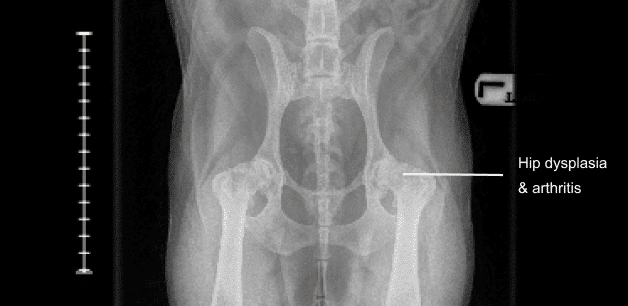Arthritis awareness
If you’re a dog parent like me, then I’m sure their well-being is a top priority. Although it’s sad to admit, our once energetic pup will eventually enter their senior years. Sometimes, age-related health conditions can start cropping up too, such as arthritis.
Arthritis is a degenerative, inflammatory disease which affects the joints. It impacts 80% of dogs above the age of 8, and as many as 35% of dogs across all age groups. If left undiagnosed and untreated, arthritis in dogs can become a long-term problem. It can develop in dogs of any age, not just older dogs.
Our family dog Tilly suffered with arthritis, as do many golden retrievers and larger breeds, however she went on to live for 17 strong years and with careful management she lived a fulfilled and happy life.
In this blog I’ll be highlighting some of the symptoms and signs of arthritis in dogs. I’ll also provide advice on things you can do to manage your dog’s arthritis at home. If your dog is struggling with joint pain, you’re in the right place! I’m here to offer my top tips.

What is Arthritis?
Arthritis is often described as “joint inflammation”, but it’s more complex than this. Many people believe it only affects the cartilage, but it actually affects all parts of the joint. If not diagnosed early and managed well, arthritis can lead to complete joint damage in dogs.
Arthritis causes inflammation, thickening of the joint’s membrane, thinning of joint fluid, and the growth of new bone around the joint. This results in difficult, painful movement as bones rub together, weakened ligaments, and increased pain signals to the brain. If left untreated, chronic pain can become debilitating.
Arthritis can affect any dog. However, there are certain elements that can make your dog more susceptible to this disease. These can include breed, age, genetics, weight and diet to name a few.

Symptoms to watch out for
Dogs can display symptoms of joint problems in lots of different ways. Sometimes, signs can be so subtle, they’re easy to miss.
Firstly, it’s important to establish what’s normal for your dog. Pay attention to their everyday actions like walking, toileting, or getting up after resting. Learning your dog’s habits will enable you to easily notice changes in their movement as they age.
Here are some common symptoms of arthritis in dogs to watch out for:
Stiffness or limping especially when getting up after a lie down
Shortened stride
Head nodding when walking or trotting
Licking and chewing at certain joint locations
Excessive panting even if it isn’t hot
General grumpiness and irritability
Reluctance to exercise
Difficulty posturing when going to the toilet
Falling behind on walks
Muscle wastage
If your dog displays any of these symptoms, it’s a good idea to schedule a vet visit. Dogs can be very stoic and tend to hide their pain. Even if your dog shows mild symptoms, a pain medication trial often significantly improves their well-being and mobility.
Common treatments for arthritis in dogs
Sadly, arthritis in dogs has no cure. Treating arthritis in dogs revolves around reducing pain, increasing mobility, and enhancing quality of life. Slowing down the disease’s progression is crucial for dogs with arthritis.
Vets typically x-ray first to diagnose arthritis. They’ll then use a combination of treatments to find the most effective approach. This is because not every treatment option will work for every dog.
Here are some vet recommended treatments for dogs suffering with arthritis:
Pain medication such as anti inflammatories.
Joint supplements, especially those with high levels of Omega 3 and 6 fatty acids such as Antinol.
Other treatments
Your vet might suggest other treatments like physiotherapy, hydrotherapy or acupuncture for your dog’s arthritis. These methods focus on relaxing and strengthening the muscles and ligaments around the affected joints to reduce inflammation and provide pain relief. Surgery is also an option but it’s usually a last resort due to the possible risks and side effects.
Additionally, changing your dog’s diet can significantly aid in combating inflammation. A natural, healthy diet provides lots of benefits, including a stronger immune system which is essential for fighting infections and inflammation. It also reduces the risk of excessive weight gain when portioned correctly. Discover how James & Ella’s freeze-dried raw food can help your dog!
What else can I do to help?
If you’re worried your dog might be struggling with joint pain, there are lots of things that you can implement at home to help to make things easier for them. Here are some of my best tips:
Use books or a stand to raise food and water bowls to just below shoulder height.
Use non-slip tape on hard or laminate flooring.
Short, slow but frequent walks throughout the day.
Stretching and strengthening exercises before and after exercise, such as simply asking your dog to repeatedly stand from a sitting position.
Reduce your dog’s food intake if they need to lose weight – swimming is also fantastic for weight control!
If necessary, use a stair gate to prevent your dog from going up and down the stairs.
Use a car ramp to make it easier for your dog to enter and exit the car.
Avoid walking in cold, damp weather if it’s likely to cause a soreness flare up.
Often, small changes in routine can make a huge difference to your dog’s wellbeing, especially if they’re suffering with arthritis. Increasing comfort and low level, daily exercise is key, to keep the joints mobilised but not overworked.
Slow and steady wins the race
Arthritis in dogs can be heartbreaking, but with proper treatment, many can improve almost instantly. While there’s no cure, there is hope. Many arthritic dogs live long, healthy lives with the right care and lifestyle adjustments. It’s important to make any changes to their diet or routine slowly and gradually, under veterinary supervision.
I hope this blog has given you useful tips for how to manage arthritis in dogs. If your dog has joint pain and you’re unsure of what to do, consult your vet first. With a good management routine and a nutritious diet, arthritis can be successfully managed for years.
If you need dietary help or have any questions at all, email me at james@ella.co. I’d love to hear from you!
Until next time,
James x



